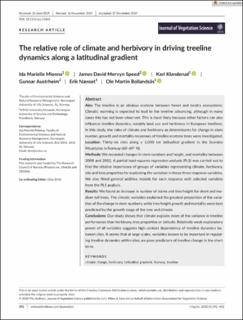| dc.contributor.author | Mienna, Ida Marielle | |
| dc.contributor.author | Speed, James David Mervyn | |
| dc.contributor.author | Klanderud, Kari | |
| dc.contributor.author | Austrheim, Gunnar | |
| dc.contributor.author | Næsset, Erik | |
| dc.contributor.author | Bollandsås, Ole Martin | |
| dc.date.accessioned | 2021-02-18T13:04:19Z | |
| dc.date.available | 2021-02-18T13:04:19Z | |
| dc.date.created | 2020-03-16T14:48:19Z | |
| dc.date.issued | 2020 | |
| dc.identifier.citation | Journal of Vegetation Science. 2020, 31 (3), 392-402. | en_US |
| dc.identifier.issn | 1100-9233 | |
| dc.identifier.uri | https://hdl.handle.net/11250/2728950 | |
| dc.description.abstract | Aim
The treeline is an obvious ecotone between forest and tundra ecosystems. Climatic warming is expected to lead to the treeline advancing, although in many cases this has not been observed. This is most likely because other factors can also influence treeline dynamics, notably land use and herbivory in European treelines. In this study, the roles of climate and herbivory as determinants for change in stem number, growth and mortality responses of treeline ecotone trees were investigated.
Location
Thirty‐six sites along a 1,000 km latitudinal gradient in the Scandes Mountains in Norway (60–69° N).
Methods
We recorded changes in stem numbers and height, and mortality between 2008 and 2012. A partial least‐squares regression analysis (PLS) was carried out to find the relative importance of groups of variables representing climate, herbivory, site and tree properties for explaining the variation in these three response variables. We also fitted general additive models for each response with selected variables from the PLS analysis.
Results
We found an increase in number of stems and tree height for short and medium tall trees. The climatic variables explained the greatest proportion of the variation of the change in stem numbers, while tree height growth and mortality were best predicted by the growth stage of the tree and climate.
Conclusions
Our study shows that climate explains more of the variance in treeline performance than herbivory, tree properties or latitude. Relatively weak explanatory power of all variables suggests high context dependency of treeline dynamics between sites. It seems that at large scales, variables known to be important in regulating treeline dynamics within sites are poor predictors of treeline change in the short term. | en_US |
| dc.language.iso | eng | en_US |
| dc.publisher | Wiley | en_US |
| dc.rights | Navngivelse 4.0 Internasjonal | * |
| dc.rights.uri | http://creativecommons.org/licenses/by/4.0/deed.no | * |
| dc.title | The relative role of climate and herbivory in driving treeline dynamics along a latitudinal gradient | en_US |
| dc.type | Peer reviewed | en_US |
| dc.type | Journal article | en_US |
| dc.description.version | publishedVersion | en_US |
| dc.source.pagenumber | 392-402 | en_US |
| dc.source.volume | 31 | en_US |
| dc.source.journal | Journal of Vegetation Science | en_US |
| dc.source.issue | 3 | en_US |
| dc.identifier.doi | https://doi.org/10.1111/jvs.12865 | |
| dc.identifier.cristin | 1801875 | |
| dc.description.localcode | This is an open access article under the terms of the Creative Commons Attribution License, which permits use, distribution and reproduction in any medium, provided the original work is properly cited. © 2020 The Authors. Journal of Vegetation Science published by John Wiley & Sons Ltd on behalf of Internation Association for Vegetation Science | en_US |
| dc.description.localcode | This is an open access article under the terms of the Creative Commons Attribution License, which permits use, distribution and reproduction in any medium, provided the original work is properly cited. © 2020 The Authors. Journal of Vegetation Science published by John Wiley & Sons Ltd on behalf of Internation Association for Vegetation Science | en_US |
| cristin.ispublished | true | |
| cristin.fulltext | original | |
| cristin.qualitycode | 1 | |

